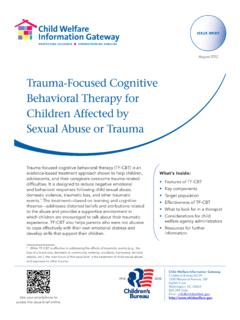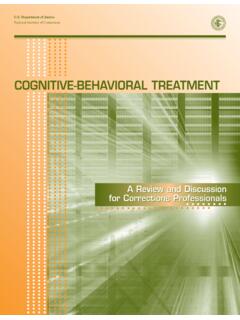Transcription of Cognitive-Behavioral Therapy for Managing Pain
1 Cognitive-Behavioral Therapyfor Managing Pain 2/6/196 Michael Lewandowski, Clinical ProfessorDepartment of PsychiatrySchool of MedicineAdjunct Faculty Psychology DepartmentUniversity of Nevada Why CBT? People are not disturbed by events, but rather the view that they take of them. Epictetus Greek Stoic Philosopher Things are neither good or bad but thinking makes it so. Shakespeare There is usually a strong connection between how you think and how you feel. It may not be what happens to you that causes you to become anxious or tense but what you tell yourself about what happens. Gatchel2007 The American Medical Association Agrees: Treatment of Chronic pain: does not lend itself to strict, non-subjective, physical laboratory standards Is not detectable or measurable on the basis of traditional, physical, tissue-oriented, medical disease model Requires acknowledging and understanding a multifaceted bio-psycho-social model that transcends the disease Medical Association (1995).
2 Pain. In T. C. Doegeand Houston (Eds.), Guides to the evaluation of permanent impairment (4th edition ChicagoWhat we know The past 2 decades: Clinical researchers studying pain emphasize the important role that certain specific sets of negative beliefs (such as catastrophizing and fear avoidance) play in the maintenance and exacerbation of chronic pain. GatchelRJ, Peng YB, Peters ML, Fuchs PN, Turk DC. The biopsychosocial approach to chronic pain: scientific advances and future directions. Psychology Bulletin. 2007;133(4) and Goals Learn what is/isn t CBT Understand Treatment Strategies What is the research behind CBT Identify the three different waves philosophies of CBT Learn strategies for impeding the onset of chronic pain9 Words Matter?WHAT CBT IS NOTC ognitive behavioral Therapy should not be confused with the following: ECT (joking) Psychoanalysis- This Freudian approach aims to get at the bottom of subconscious determinants of your actions/behavior.)
3 Person-centered/ humanistic Therapy - This approach involves a mostly-passive therapist that says little during sessions in an attempt to have you resolve your issues cognitive behavioral Therapy ? Because cognitive behavioral Therapy helps provide pain relief: It changes the way people view their pain. CBT can change the thoughts, emotions, and behaviors related to pain, improve coping strategies, and put the discomfort in a better context. You recognize that the pain interferes less with your quality of life, and therefore you can function Therapy (CBT) A psycho-social intervention Most widely used evidenced-based practicefor improvingmental health. Guided by empirical research, CBT focuses on the development of personalcoping skillsthat target solving current problems and changing unhelpful patterns in cognitions ( thoughts, beliefs, and attitudes), behaviors, and emotional regulation.
4 Originally designed to treat depression Our thinking gets sticky = Stuckness = no blameThe Challenge of PainOver time, negative thoughts and beliefs aboutpain and behaviors related to pain (pain behaviors) can becomevery resistant to change. Thoughts BehaviorsTHOUGHTS about PAIN My pain is going to kill me This is never going to end I'm worthless to my family I m disabled There is nothing I can dofor myself BEHAVIORS Staying in bed all day Walking with a limp/holding your head/frowning Sleeping all day Staying away from friends Decreasing activities thathave the potential toincrease pain Taking more medicationthan prescribed Pain behaviors and Wilbert FordyceCritical Educational Points What are the critical components of the CBT model that need to be communicated to the person with persistent pain: Pain includes: physiological sensations, AND emotions, behaviors, thoughts.
5 Pain includes: personal, social and environmental influences or stresses in our lives ( , personality, physical limitations, relationships, medical care, life roles, physical environment-weather and climate) These thoughts often are negative and unrealistic about having pain and the future given the pain In turn, these can impact how we feel emotionally and what we do when in pain -(withdraw and avoid) Traps in our thinking that negatively impact pain There are underlying beliefs about pain: automatic thoughts and core beliefs. Medical versus Rehabilitation Views of Pain Another critical component of pain management People with persistent pain may be inclined to look for relief through medical procedures They need to be regularly reoriented towards implementing self-care : Event => Thoughts => Feelings => BehaviorCrEvent Emotions Behaviors ANGERE ventI don t deserve thisFeelingCase Examples: Phil and Sally Phil is a 32 year old Caucasian male Experiences burning and numbing LB and legs Is frustrated/sad thinks: this pain is horrible; it s unbearable; I can t go on like this He imagines pain taking over his whole body His pain worsens.
6 He becomes absorbed in his pain, frustration and sadness Sally is a 49 year old Japanese female Experiences burning and numbing LB and legs She feels slightly irritated - thinks here comes the pain again-I know it s gonnahurt so what can I do? I need to catch my breath and focus on something else; distract myself; I have to remember the pain will subside if I take steps to manage it. I have to focus on relaxing my body and moving through the pain. It s not time for my next pain pill. cognitive Errors A negatively distorted belief about oneselfor ones situation The role of Catastrophizing Of all of the psychological factors that have been studied and shown to be associated with pain and its impact on our lives, the single most consistent (and to date among the strongest) factor associated with pain is catastrophizing Jensen (2015)A recent survey ofPractical Pain Managementreaders (2017) revealed that 66% of the respondents were unfamiliar with the construct of pain Beliefs about having Persistent Pain Pain catastrophizing an exaggerated negative orientation toward actual or anticipated pain conceptualizations most often describe it in terms of appraisal or as a set of maladaptive beliefs.
7 GatchelRJ, Peng YB, Peters ML, Fuchs PN, Turk DC. The biopsychosocial approach to chronic pain: scientific advances and future directions. Psychology Bulletin. 2007;133(4):581-624. This pain is awful. I will be stuck with this pain forever. I can t stand this pain. What if my pain never gets better? My future is shot. If I have this kind of pain now, it is going to get worse, and it will be terrible by the Pain catastrophizing has been found to intensify the experience of pain and depression. A recent meta-analysis concluded that higher pain catastrophizing often is associated with higher self-reported pain and disability, and may lead to delayed recovery in patients with low back pain. A separate meta-analysis determined that decreased catastrophizing during treatment for low back pain was associated with better outcomes. Sullivan MK, D Relation betweencatastrophizing and depression in chronicpain patients.
8 J AbnormPsychol. 1990;99(3):260-263. WertliMM, EugsterR, Held U, SteurerJ, Kofmehl R, Weiser S. Catastrophizing a prognosticfactor for outcome in patients with low back pain: a systematic review. Spine J. 2014;14(11):2639-2657. WertliMM, BurgstallerJM, Weiser S, SteurerJ, Kofmehl R, Held U. Influence of catastrophizing on treatment outcome in patients with nonspecific low back pain: a systematic review. Spine. 2014;39(3) beliefs about pain or disability arebetter predictors of ultimate level of disabilitythan are physician ratings of disease severityWhat Can CBT Do? CBT can change the physical response in thebrainthat makes pain worse. Pain causes stress, and stress affects pain control chemicals in the brain,such as norepinephrine and serotonin. CBT reduces the arousal that impacts these chemicals. This, in effect, may make the body s natural pain relief response more powerful.
9 Self management approach to pain -Moving people with pain toward self-Management What Can CBT Do? CBT is used together with other methods of pain management. includemedications,physical Therapy ,weight loss, massage, acupuncture or in extreme cases, surgery. Three shifts in perspective for patients with chronic pain to effectively self-manage their condition: accepting diagnosis of chronic pain; understanding the mind/body connection with regard to pain symptomatology; and changing to an active orientation regarding self-management. CBT is almost always as least as good as or better than other treatments. CBT has far fewer risks and side effects than medications or does CBT help with Pain Relief? Encourages a problem-solving attitude. The worst thing about persistent painis the sense of learned helplessness -- there is nothing I can do about this pain.
10 If you take action against the pain (no matter what that action is), you will feel more in control and able to impact the situation. Involves homework. CBT always includes homework assignments, keeping track of the thoughts and feelings associated with your pain throughout the day in a journal Encourages life skills. CBT is skills training. It gives patients coping mechanisms they can use in everything they do. You can use the tactics you learn for pain control to help with other problems you may encounter in the future, such as stress, depression or anxiety. Allows you to do it yourself. Unfortunately, good qualified cognitive behavioral therapists aren t available in all areas. You can conduct CBT on your own as a method of pain control. Literature supports that these self-help methods can be just as effective for pain management as one-on-one Behavior Therapy - Pain Three interrelated phases Emphasis on a distinction between acute versus persistent/chronic pain; pain as manageable and controllable; emphasis on learning a pain self-management approach Skills acquisition; behavioral activation and learning adaptive cognitive and behavioral pain coping skills Maintenance and relapse prevention.









